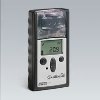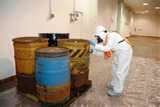
This free webinar features two specialists from Industrial Scientific Corp. explaining how Gas Detection as a Service solves common difficulties, increasing the visibility of your data and allowing you to take action.

Sixteen companies win top honors in the magazine's second annual contest, with trophies and ribbons handed out Tuesday at the National Safety Council Congress & Expo in San Diego.
The new system features moisturizing and antibacterial soaps, sanitizers, and lotions that keep facility employees and guests clean and healthy.
The company Kent McElhattan co-founded on Oct. 1 announced his election to succeed Joseph J. Ucciferro, who served as National Safety Council board chairman for the past three years. Mark P. Vergnano, executive vice president of DuPont, was elected to a two-year term as vice chairman.
The company is being cited for allegedly failing to keep an area clean and free of dangerous accumulations of explosive and combustible foam dust and for failing to install machine guards on cutting machines to protect workers from amputation hazards.
The new requirements will be a compliance burden for many businesses. Automated distribution is the "Easy Button" for HazCom compliance.

Safety professionals have long had concerns with MSDSs, beginning with issues about the ability of workers to understand them.

Dispensing solvents from large containers into smaller ones or spending more to buy solvents in smaller containers weren't appealing. This pharmaceutical company found a different solution for meeting the fire codes.

A standardized technical performance specification template for portable gas monitoring instruments is being developed. Until then, users must be diligent in examining the specifications.

The agency's second report on all 50 states and four localities receiving federal money for this shows improved ability to meet a public health emergency.
According to DOE, the 2009 IECC now available will produce approximately 15 percent in residential energy efficiency gains compared to the 2006 edition.

Meeting Oct. 12 and Oct. 20, the commissioners will examine progress to date on integrating safety throughout the Commerce Department organization.
Sixteen organizations receive $2.75 million in one-year grants to develop training materials about nanomaterials, work zone safety, green roofing jobs, beryllium, and several others.
The agency and the National Science Foundation Center for High-rate Nanomanufacturing, a collaboration of the University of Massachusetts Lowell, Northeastern University, and the University of New Hampshire, will study occupational health and safety concerns related to the nanotechnology industry.

"Respiratory Diseases and the Fire Service" addresses smoking, pulmonary function testing, World Trade Center responders' respiratory diseases, disaster-related infections, and much more.

Three informal public meetings next month will gather information from the industry about effective safety and health management programs already in use at U.S. mines. Comments are due by Dec. 17.
An inspection’s sampling of water from various locations on the property confirmed the discharge of boron, arsenic, copper, ammonia, zinc, chromium, cobalt, manganese, nickel, selenium, aluminum, barium, cadmium, and 2-Butanone into the Weaver Branch tributary.
The declaration was designed as a blueprint for constructing a global ethos of safety and health at work and to promote a preventative safety and health culture and assert the rights of employees to work in a safe environment.
The citations allege, among other things, that the company did not take air samples as required for workers who were overexposed to airborne lead nor provide the required annual training associated with the hazards. An additional willful violation alleges that the company stopped providing hearing tests to employees overexposed to noise.
Better air = better performance.